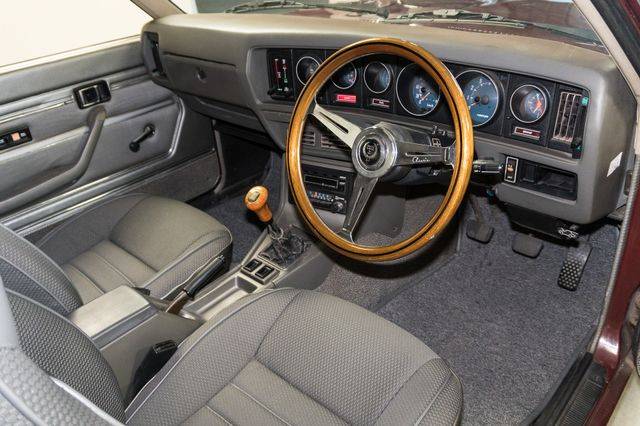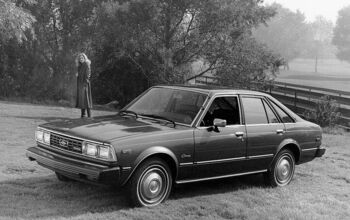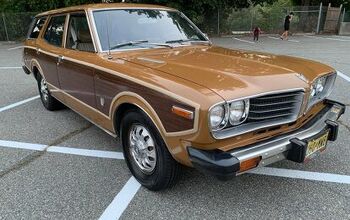Rare Rides: A 1974 Toyota Corona 2000 GT

Today’s Rare Ride is a case of forbidden fruit. Though North American consumers could buy something similar, this Rare Ride was never on domestic shores as new.
It’s the Toyota Corona 2000 GT, from 1974.
Toyota’s Corona line entered production in 1957. A compilation of parts from a recently deceased Crown, it was made to fill the space the (now larger) Crown vacated. Over the years the Corona grew in size and model variation, and became an important global model for Toyota. Additional production began in Australia in the sixties, and by the early seventies it was also produced in Indonesia and South Africa.
After a short fourth generation of just four model years, the fifth-gen Corona entered production late in 1973. By that time it was a midsize entry, and occupied a place between the smaller Carina and the larger, more luxury-oriented Mark II. Body styles included two- and four-door sedans, a five-door wagon, and the rakish two-door hardtop coupe.
As expected, North American Coronas had big, chunky bumpers to meet new crash standards. Though a variety of engines were used in other markets, North American Coronas had just one: the 20R. Toyota liked the 2.2-liter unit for North American applications. Its 97 horsepower also motivated the Hilux and Celica of the period. Transmissions included three- and four-speed manuals, and a three-speed automatic.
For its domestic market only, Toyota built two hotter versions of the Corona. Dubbed the 2000 GT, a sporty sedan was accompanied by a hardtop coupe to form the top of the Corona line. These models used the twin cam 18R-G engine. A two-liter unit designed to fit into the small car tax bracket in Japan, the 18R-G produced 143 horsepower and 130 lb-ft of torque in a car that weighed around 2,200 pounds. North Americans stayed content with their 97-horsepower truck engine.
The Corona faced an uphill battle in the US. Front-drive economy was all the rage, and entries like the new Honda Accord and Subaru DL gained market share. The fifth generation finished off the seventies before it was replaced by a short-lived sixth generation that persevered through 1983. It was not missed, as Americans embraced the brand new front-drive Camry with open arms. By 1983 there was a front-drive Corona in other markets, as the model began its descent. Through the remainder of its life (model year 2002) the Corona turned into a Corolla-like vehicle for markets outside North America, and eventually spawned Caldina wagon variants.
Today’s burgundy beauty is a 1974 2000 GT coupe. All 143 horsepower are shifted via the five-speed manual, and everything looks in original condition. 2000 GT is yours for $25,995.
Images: seller]

Interested in lots of cars and their various historical contexts. Started writing articles for TTAC in late 2016, when my first posts were QOTDs. From there I started a few new series like Rare Rides, Buy/Drive/Burn, Abandoned History, and most recently Rare Rides Icons. Operating from a home base in Cincinnati, Ohio, a relative auto journalist dead zone. Many of my articles are prompted by something I'll see on social media that sparks my interest and causes me to research. Finding articles and information from the early days of the internet and beyond that covers the little details lost to time: trim packages, color and wheel choices, interior fabrics. Beyond those, I'm fascinated by automotive industry experiments, both failures and successes. Lately I've taken an interest in AI, and generating "what if" type images for car models long dead. Reincarnating a modern Toyota Paseo, Lincoln Mark IX, or Isuzu Trooper through a text prompt is fun. Fun to post them on Twitter too, and watch people overreact. To that end, the social media I use most is Twitter, @CoreyLewis86. I also contribute pieces for Forbes Wheels and Forbes Home.
More by Corey Lewis
Latest Car Reviews
Read moreLatest Product Reviews
Read moreRecent Comments
- Jalop1991 In a manner similar to PHEV being the correct answer, I declare RPVs to be the correct answer here.We're doing it with certain aircraft; why not with cars on the ground, using hardware and tools like Telsa's "FSD" or GM's "SuperCruise" as the base?Take the local Uber driver out of the car, and put him in a professional centralized environment from where he drives me around. The system and the individual car can have awareness as well as gates, but he's responsible for the driving.Put the tech into my car, and let me buy it as needed. I need someone else to drive me home; hit the button and voila, I've hired a driver for the moment. I don't want to drive 11 hours to my vacation spot; hire the remote pilot for that. When I get there, I have my car and he's still at his normal location, piloting cars for other people.The system would allow for driver rest period, like what's required for truckers, so I might end up with multiple people driving me to the coast. I don't care. And they don't have to be physically with me, therefore they can be way cheaper.Charge taxi-type per-mile rates. For long drives, offer per-trip rates. Offer subscriptions, including miles/hours. Whatever.(And for grins, dress the remote pilots all as Johnnie.)Start this out with big rigs. Take the trucker away from the long haul driving, and let him be there for emergencies and the short haul parts of the trip.And in a manner similar to PHEVs being discredited, I fully expect to be razzed for this brilliant idea (not unlike how Alan Kay wasn't recognized until many many years later for his Dynabook vision).
- B-BodyBuick84 Not afraid of AV's as I highly doubt they will ever be %100 viable for our roads. Stop-and-go downtown city or rush hour highway traffic? I can see that, but otherwise there's simply too many variables. Bad weather conditions, faded road lines or markings, reflective surfaces with glare, etc. There's also the issue of cultural norms. About a decade ago there was actually an online test called 'The Morality Machine' one could do online where you were in control of an AV and choose what action to take when a crash was inevitable. I think something like 2.5 million people across the world participated? For example, do you hit and most likely kill the elderly couple strolling across the crosswalk or crash the vehicle into a cement barrier and almost certainly cause the death of the vehicle occupants? What if it's a parent and child? In N. America 98% of people choose to hit the elderly couple and save themselves while in Asia, the exact opposite happened where 98% choose to hit the parent and child. Why? Cultural differences. Asia puts a lot of emphasis on respecting their elderly while N. America has a culture of 'save/ protect the children'. Are these AV's going to respect that culture? Is a VW Jetta or Buick Envision AV going to have different programming depending on whether it's sold in Canada or Taiwan? how's that going to effect legislation and legal battles when a crash inevitibly does happen? These are the true barriers to mass AV adoption, and in the 10 years since that test came out, there has been zero answers or progress on this matter. So no, I'm not afraid of AV's simply because with the exception of a few specific situations, most avenues are going to prove to be a dead-end for automakers.
- Mike Bradley Autonomous cars were developed in Silicon Valley. For new products there, the standard business plan is to put a barely-functioning product on the market right away and wait for the early-adopter customers to find the flaws. That's exactly what's happened. Detroit's plan is pretty much the opposite, but Detroit isn't developing this product. That's why dealers, for instance, haven't been trained in the cars.
- Dartman https://apnews.com/article/artificial-intelligence-fighter-jets-air-force-6a1100c96a73ca9b7f41cbd6a2753fdaAutonomous/Ai is here now. The question is implementation and acceptance.
- FreedMike If Dodge were smart - and I don't think they are - they'd spend their money refreshing and reworking the Durango (which I think is entering model year 3,221), versus going down the same "stuff 'em full of motor and give 'em cool new paint options" path. That's the approach they used with the Charger and Challenger, and both those models are dead. The Durango is still a strong product in a strong market; why not keep it fresher?







































Comments
Join the conversation
I see a couple of things. The air cleaners don't look stock - knowing how anal retentive the Japanese manufacturers were about things like that, I'd expect to see a huge oval housing covering both carbs, with a snorkel coming off the front that's tilted down, the big stamped wing nuts at each carb that go pop-pop-pop once they make contact (ridges on the bottoms of the nuts that mate with grooves stamped in the housing - anti-vibration), and something like six of those flip-down clamps they like to use around the perimeter. I also see that the rubber body plugs are missing from the spare tire well.
This a good Rare Ride. I think though for the money a Celica coupe would provide the same enjoyment and looks like a close cousin. Theres a fairly clean orange coupe parked in my in-laws neighborhood that i'm sure is a nonrunner but a good candidate for restoration. I wish I had the time or space.